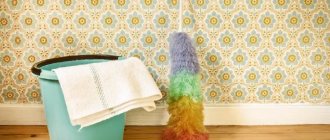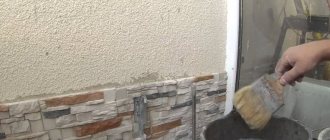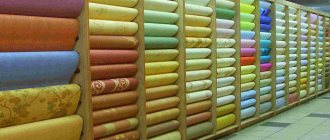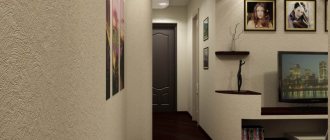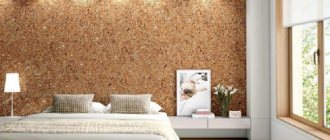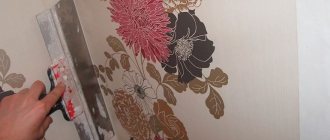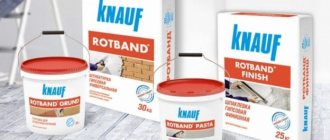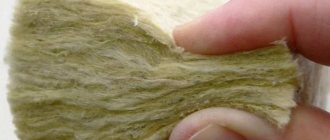What are the properties of non-woven wallpaper?
To produce non-woven fabric, long cellulose fibers are taken. This gives them:
- Wallpaper made from this material does not get wet and is wear-resistant. Unlike paper materials, they are more difficult to spoil.
- When compressed or wrinkled, the interlining easily straightens out.
- Non-woven wallpaper does not attract dust and is difficult to get dirty. Washing is allowed if necessary.
- This type of wallpaper is very resistant to fire.
- Suitable for absolutely all categories of people.
- It is not afraid of dampness due to its moisture-repellent properties. Thanks to its qualities, it has a very long service life.
Thus, it is no coincidence that this type of finishing material has gained great popularity. In addition to excellent quality, positive aspects include the softness of the material and ease of working with it. If paper wallpaper requires a certain skill, since it is easy to damage, then even a novice master can handle non-woven wallpaper. When the time comes to change the wallpaper, it will peel off very easily from the wall surface without causing much trouble.
What is non-woven fabric
There are several types of wallpaper that contain non-woven fabric. This is a material produced by a non-woven method, consisting of 70% cellulose fibers (paper) and binders (30%). It looks like paper, but feels like fabric. It is obtained by pressing.
This material has been known for a long time and is widely used in various fields. For example, in the clothing industry. The clothing parts are glued with non-woven fabric for strength and shape retention. It is environmentally friendly, has good air permeability, and has many other high characteristics.
What are the disadvantages of this material?
Like any other type of finishing material, non-woven wallpaper has its disadvantages:
- If the terrain is large, then the wallpaper will become dirty faster.
- Wet cleaning of non-woven wallpaper with large relief is prohibited so as not to damage the relief. This is a big minus in the kitchen.
- This type of material is more expensive than many other wallpapers. The amount of expenses increases if you choose non-woven wallpaper for painting.
Despite these disadvantages, non-woven wallpaper has many more advantages. In addition, for any occasion you can choose the best design solution with this type of finishing material.
Advantages
The advantages of non-woven wallpaper over their paper counterparts are obvious:
- moisture resistance;
- stylishness;
- possibility of wet cleaning;
- do not fade in direct sunlight;
- a lot of texture;
- do not deform when gluing;
- wear resistance;
- perfectly disguises unevenness and cracks. Indispensable in new buildings, as they are able to “keep their shape” for a long time in the event of cracks forming due to inevitable shrinkage of the building;
- the ability to change color at any time by repainting;
- help retain heat.
In the manufacture of wall coverings, different densities of non-woven fabric are used: 60-150 g/m2. The larger it is, the higher the wear resistance of the product.
What types of non-woven wallpaper are there?
All types of such wallpaper are divided into two parts:
- Entirely non-woven fabric;
- The base is made of non-woven fabric coated with another material.
Wallpaper made entirely of non-woven fabric
Such wallpaper is produced smoothly in relief, in relief, painted or made for painting. But no matter what option is chosen, the pasting technique is equally simple. The prepared wall is smeared with glue, after which the canvas is glued.
There are a few things to consider:
- Non-woven wallpaper is quite heavy, you need to choose a special glue. In some cases, you can increase consumption by lubricating both the wall and the canvas.
- The material is neither compressed nor stretched. No adjustments will be needed after the sticker is applied.
- If wallpaper is selected for painting, painting is done after the glue has completely dried, no earlier than 12 hours. To change the design, it will be enough to simply repaint the wallpaper. Painting the same canvas several times is allowed.
The wall surface is quite dense; many design options will add originality to the interior and help achieve the desired effect.
In addition to those indicated, you can purchase two-layer, fully non-woven wallpaper. Their peculiarity is that during subsequent repairs it is enough to remove the top decorative layer. This is very easy to do, even without special skills. If the base remains dry and clean, it is enough to prime it and can be used as a basis for pasting any type of wallpaper. In this case, non-woven fabric completely retains its positive properties.
Vinyl covering
In the case of vinyl wallpaper on a non-woven basis, they somewhat lose their environmental friendliness, but at the same time acquire additional advantages:
- Resistant to damage. The relief of such wallpaper is more difficult to damage than pure non-woven fabric. If there are children or animals, vinyl covering will be an advantage.
- Kitchen area. In the kitchen, this type of wallpaper will be more appropriate than pure non-woven fabric. Vinyl does not deteriorate from stuffiness and moisture, it can be easily washed even with household chemicals, and the non-woven base will not allow fungus and mold to grow on the wall.
- Fire resistance. Like non-woven wallpaper, vinyl-coated material remains fire resistant.
If you purchase such finishing material for painting, it is worth considering that they can be painted no more than 5 times, the painting process is a little more complicated than that of completely non-woven ones, but due to the more pronounced texture of the canvas, the design of the room will benefit in appearance.
Paper covering
Such wallpaper remains completely environmentally friendly thanks to the natural paper coating. If you decide to purchase paper wallpaper, you should prefer the non-woven version for the following reasons:
- Waterproofing. High air humidity can ruin paper wallpaper. The non-woven base will protect such a covering from dampness and protect against the appearance of fungus or mold.
- Easy stickers. Paper wallpaper on a non-woven basis is much easier to paste than all-paper wallpaper. They do not tear, do not get wet, and are easily smoothed out during the sticking process.
- Volumetric textures. Thanks to the filler and pressing, interesting appearance options are obtained. Simple paper wallpaper will not have this effect.
- Price. When it comes to which non-woven wallpaper to choose based on price, paper-backed wallpaper is the most profitable option.
The non-woven base thus eliminates many of the disadvantages of paper wallpaper. However, it is still worth paying attention to their unsuitability for kitchen lining and flammability.
Textile covering
Textiles in the interior have a number of advantages. It looks luxurious, has soundproofing and heat-insulating qualities, a long service life, and is resistant to fading in the sun.
Like any other material, it has weaknesses. The disadvantages of textile fabric can be easily solved using a non-woven base:
- Odor accumulation. Textiles absorb odors very well. The non-woven base, due to its “breathable” qualities, will increase the breathability of the textile, eliminating this drawback.
- Easy pasting. When pasting, the wall is coated with an adhesive composition, after which the wallpaper is applied to it with a non-woven dry base; contact of the glue with the textile covering is completely excluded. There is no risk of damaging the canvas with glue.
Features of the sticker
The sticker instructions in our case are quite typical for thick wall coverings:
- The strips are glued end to end.
- Viscous adhesives are used for heavy wallpaper.
In the photo there is a special non-woven glue.
- The wall must first be cleaned of old coatings and primed with penetrating acrylic primer.
The difference between the technology and the one we are used to is that the glue is applied only to the wall. There is no need to coat the canvas itself.
However, there is an exception here too. It is better to coat thick vinyl with non-woven backing with glue along with the base; Moreover, it is worth adding PVA to the glue at the rate of approximately 500 milliliters per bucket. In this case, after drying, the coating is guaranteed not to move away from the base.
How to properly stick non-woven wallpaper?
First of all, you need to prepare the wall. To do this, remove the old finish - wallpaper, paint, and if necessary, sand it with sandpaper. The surface of the wall must be leveled and primed. If these actions have been performed previously or are not required, the surface must be dust-free.
The next steps are not difficult even for a beginner:
1) Prepare the glue. To paste this type of finishing material, a special glue for non-woven wallpaper is required. Dilute it according to the instructions. Often it takes 15 to 30 minutes.
2) Cut the wallpaper. The presence of a picture should be taken into account. If necessary, the canvas is adjusted according to the drawing. If this is not required, it is worth cutting about 5 cm more than the height of the wall along the top and bottom of the canvas.
3) Apply glue to the wall. Excess glue may ooze out along the edges of the wallpaper, ruining the appearance of the canvas. If there is a lack of glue, the canvas will move away from the wall. To check the amount of glue, you need to run your finger. If the mark remains, there is enough glue.
4) We carry out pasting. The dry canvas is leaned against the wall, pressed tightly, possible irregularities are smoothed out, and air bubbles are removed. You should start from a corner near the window, then the seams will be less noticeable. Glue the canvases at the joint.
5) We complete the pasting. We trim the excess material along the top and bottom, remove excess glue with a sponge or rag. It is worth considering that the glue should be removed immediately, otherwise the canvas may be completely damaged. Removing fresh glue is easy and does not leave any marks on the material.
You need to be careful when working with vinyl flooring. Removing glue from such a surface must be gentle so as not to damage the vinyl.
Base for painting
If they are used under a paint layer, then for gluing non-woven wallpaper you need to choose a more durable special glue. If this is not done, then the wallpaper will slide down under its own weight.
You can start painting only after the wallpaper has completely dried. It is applied as with normal wall painting. It is better to use a roller to better paint over relief designs. Paints must be water-dispersed. When coated with oil, the recesses of the relief patterns become clogged and become less expressive.
What sizes of non-woven wallpaper do manufacturers produce?
Non-woven wallpaper is heavy and durable materials. After pasting, it is necessary that there are as few joints as possible. For this reason, the width of the roll is usually 1.06 m. It is worth noting that the width of thin wallpaper is much smaller. This is due to the fact that thin material can tear; it will be difficult to work with material of significant width. Non-woven fabric is free of these disadvantages. In this case, a fairly significant indicator is an advantage.
The roll length is standard for all types of non-woven wallpaper. The value of this parameter is 10.05 m.
Paintable wallpaper is the only exception. The length of a roll of such wallpaper is 25 m.
Compound
What is non-woven wallpaper made of?
Ordinary non-woven fabric looks like a non-woven paper-like material of white or yellowish color. To achieve particularly durable qualities in the production of wallpaper, cellulose and textile fibers with polymer binders are used. Using the continuous casting method, the liquid base is transformed into a long ribbon. Then it is glued, pressed, dried and rolled. The result is a two-layer product that has a backing and a decorative coating.
How to care for non-woven wallpaper?
Caring for non-woven wallpaper is not difficult. All types can be cleaned with a dry brush or sponge. Depending on the type, some features appear:
- Fully non-woven wallpaper with large relief. They need to be cleaned with a soft bristle brush or vacuum cleaner so as not to damage the relief.
- Fully non-woven wallpaper without relief. This material allows not only dry processing, but also wet cleaning. The material is usually marked with the permissibility of the material getting wet and the possibility of using household chemicals.
- Paintable wallpaper. Cleaning this wallpaper depends solely on the type of paint.
- Vinyl covering. Wallpaper of this type allows both regular wet cleaning and the use of household chemicals.
- Textile or paper covering. Wet cleaning is prohibited. Delicate dry cleaning with a soft bristle brush or careful use of a vacuum cleaner is allowed.
All types of non-woven wallpaper are easy to clean. This is due to the properties of non-woven fabric to repel dust. Difficulties can only arise with wallpaper with a large relief or the properties of the wallpaper paint used for painting.
Wallpapering
Before you start working, you need to know how to glue non-woven wallpaper correctly. The wallpapering process consists of several stages.
Stages of wallpapering:
- Before starting the process of gluing non-woven wallpaper, prepare the wall for gluing. Old wallpaper is removed. The surface of the wall is puttied and primed.
- The second stage requires preparing the wallpaper. You need to cut the wallpaper to the required sizes. Wallpaper should be cut according to the wallpaper pattern.
- There is no need to apply glue to the wallpaper itself. You just need to apply glue to the walls and you can start gluing the cut pieces to the walls.
- The wallpaper is smoothed with a spatula or roller. The smoothing procedure is performed from the center to the edges of the canvas.
- Excess glue is removed with dry cloths.
- The joints of the strips are ironed with a soft special roller.
Which wallpaper should you choose?
The answer to this question is not as simple as it might seem. On the one hand, this is a matter of everyone's taste. On the other hand, there are several principles to make the choice easier:
- If the question is about price, you should prefer Russian manufacturers. Their wallpaper is no worse in quality, but the price is much lower than its foreign counterparts.
- If you have a playful pet, you should opt for paintable non-woven wallpaper with an anti-vandal coating. It will be difficult for your pet to damage such wallpaper.
- The fabric covering of the wallpaper will create an atmosphere of luxury in the living room or bedroom. But for the kitchen it is worth choosing a vinyl-coated material. Paintable wallpaper will look good in a nursery.
- Just like the type of wallpaper, the color depends on the purpose of the room. Pastel shades will look good in the bedroom. For a child's room, light colors with bright accents are suitable.
- Wallpaper of any type and color should be in harmony with the style of the room and the overall color scheme. Modern style is characterized by minimalism and simple lines; wallpaper with complex relief in bright colors would be inappropriate. If you are not confident in your abilities, you should consult an experienced designer.
In any case, the finished result should, first of all, please the people living in this apartment, create an atmosphere of comfort and warmth.
What to look for when purchasing
When purchasing, you should pay attention to the following factors:
| 1 | Material of manufacture | The material of manufacture affects both the use of wallpaper and the location. Vinyl ones are perfect for places with heavy mechanical load; the rest are better placed in places where there will be less load and contact. |
| 2 | Glue requirements | Requirements for glue are sometimes indicated on the packaging. It is not necessary to purchase it from the exact brand recommended by the manufacturer - in fact, they rarely differ in special properties and most often are a common overpayment for the brand. |
| 3 | Roll width | Width affects ease of use. A narrow one is more convenient in rooms with a large number of corners and narrow elements - radiators and pipes. Wide is more suitable for large rooms with straight walls. |
| 4 | Quality | It is also worth paying attention to quality. Since non-woven wallpaper has a multi-layer structure, the edges should not “delaminate”. It is also necessary to check whether all rolls belong to the same batch. This is extremely important for dark canvases - the shade may differ between different batches, which will be extremely noticeable |
What are the features of wallpaper from different countries - manufacturers?
Among the variety of non-woven wallpapers, you need to navigate the manufacturers. Different manufacturing countries have their own characteristics:
- Germany. Leader in the production of high-quality non-woven wallpaper. German manufacturers often invite the most famous designers to collaborate. The products of these factories are of exceptional quality.
- Italy. Italian factories are more inclined towards design than quality. Their products are not as high quality as German ones, but they also maintain high levels of performance. It is not uncommon for designers with names all over the world to be invited. Several collections are released throughout the year.
- Belgium. Quality and good design at low prices. Many Russian designers turn their attention specifically to Belgian factories.
- Sweden. Laconicism, airiness, simplicity and environmental friendliness characterize non-woven wallpaper from Swedish factories.
- Russia. High quality is ensured by German equipment from Russian factories. Varied designs attract attention. The low price is a distinctive point in comparison with foreign analogues.
The conclusion suggests itself. You can purchase quality at affordable prices from Russian companies. German wallpaper will be much more expensive than all others, but for this money you can buy the highest quality and luxurious appearance.
Wallpaper or wall painting – what to choose?
What you need to know when choosing wallpaper
Preparation of materials and tools
Before pasting the walls, it is necessary to prepare tools and materials in advance: a level, a stationery knife, a spatula, a roller, a pencil, a tape measure.
It is recommended to immediately cut the wallpaper itself into strips of the required length. Wallpaper with a pattern should be measured taking into account the allowance for joining the pattern.
Note!
Wallpaper for the bedroom - 125 photos and videos of stylish and beautiful ideas for decorating a bedroom using wallpaperPaper wallpaper: TOP-130 photos and video reviews. Advantages and disadvantages of paper wallpaper. DIY gluing instructions. Colors and shades
3D wallpaper - 130 photos and videos describing how to use 3D wallpaper with your own hands


